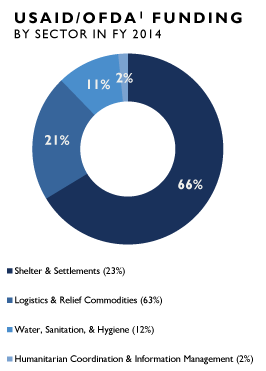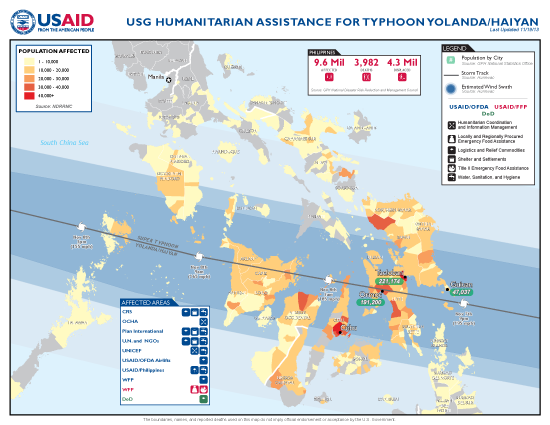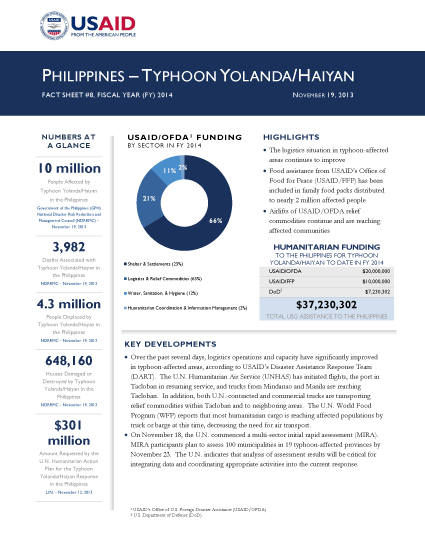- What We Do
- Agriculture and Food Security
- Democracy, Human Rights and Governance
- Economic Growth and Trade
- Education
- Ending Extreme Poverty
- Environment and Global Climate Change
- Gender Equality and Women's Empowerment
- Global Health
- Water and Sanitation
- Working in Crises and Conflict
- Disaster Assistance
- Political Transition Initiatives
- Conflict Mitigation and Prevention
- Countering Violent Extremism
- Disaster Risk Reduction
- Peacebuilding and Reconciliation
- Providing Safe & Secure Environments for Development
- Recovering From Crisis
- Resilience
- Tech Challenge for Atrocity Prevention
- World Humanitarian Day
- U.S. Global Development Lab
November 19, 2013
Numbers At A Glance
10 million
3,982
4.3 million
648,160
$301 million
Humanitarian Funding:
To The Philippines For Typhoon Haiyan/Yolanda To Date In FY2014:

| USAID/OFDA | $20,000,000 |
| USAID/FFP | $10,000,000 |
| DoD | $7,230,302 |
| TOTAL | $37,230,302 |
Typhoon Haiyan / Yolanda Fact Sheet #8 - 11/19/2013 ![]() (pdf - 210k)
(pdf - 210k)
Highlights
The logistics situation in typhoon-affected areas continues to improve
Food assistance from USAID’s Office of Food for Peace (USAID/FFP) has been included in family food packs distributed to nearly 2 million affected people
Airlifts of USAID/OFDA relief commodities continue and are reaching affected communities
Key Developments
Over the past several days, logistics operations and capacity have significantly improved in typhoon-affected areas, according to USAID's Disaster Assistance Response Team (DART). The U.N. Humanitarian Air Service (UNHAS) has initiated flights, the port in Tacloban in resuming service, and trucks from Mindanao and Manila are reaching Tacloban. In addition, both U.N.-contracted and commercial trucks are transporting relief commodities within Tacloban and to neighboring areas. The U.N. World Food Program (WFP) reports that most humanitarian cargo is reaching affected populations by truck or barge at this time, decreasing the need for air transport.
On November 18, the U.N. commenced a multi-sector initial rapid assessment (MIRA). MIRA participants plan to assess 100 municipalities in 19 typhoon-affected provinces by November 23. The U.N. indicates that analysis of assessment results will be critical for integrating data and coordinating appropriate activities into the current response.
LOGISTICS AND RELIEF COMMODITIES
- Over the past several days, the DART has observed rapidly improving logistics operations, including increased storage capacity, resumption of road and sea transport, and decreased airport congestion, facilitating the delivery of relief commodities to populations in need.
- USAID/OFDA partner WFP has established logistics hubs in Manila, Tacloban, and Cebu, with additional hubs planned for Guiuan, Ormoc, and Roxas City. WFP is installing two mobile storage units in Cebu and a warehousing complex in Tacloban, with plans to build additional mobile storage units in Tacloban and Roxas City.
- UNHAS began providing air transport for humanitarian personnel and commodities via a helicopter and two small fixed-wing aircraft on November 17. In addition, commercial airlines have resumed some scheduled service to Tacloban, facilitating the transport of humanitarian personnel.
- Container operations at the Tacloban port are scheduled to resume in coming days. In response, WFP is initiating the shipment of food and relief commodities directly to Tacloban for immediate distribution.
- WFP reports that the Mindanao–Tacloban and Manila–Tacloban road networks are open. WFP is currently operating 60 cargo trucks along the Mindanao–Tacloban route, with an average transit time of two days, and utilizing 30 contracted trucks to support cargo operations in and around Tacloban. Additional commercial trucks are also becoming available for humanitarian transport in affected areas.
- Given fuel shortages, the Logistics Cluster—the coordinating body for humanitarian logistics activities in the Philippines—plans to provide 20,000 liters of fuel to the humanitarian community, according to the U.N. In addition, the Fuel Relief Fund and Petron have provided approximately 6,000 liters of fuel to 1,000 local relief organizations to assist with relief efforts.
- To date, DoD has contributed more than $7 million for the Typhoon Yolanda/Haiyan response, primarily for airlifts and other logistical support. DoD has evacuated more than 9,800 Filipinos, 475 American citizens, and 290 third-country nationals from typhoon-affected areas. U.S. military personnel and the Government of the Philippines (GPH) continue to transport USAID-provided food commodities, hygiene kits, and water containers to the GPH Department of Social Welfare and Development (DSWD) warehouse in Tacloban for onward distribution.
- USAID/OFDA has provided approximately $9.7 million—representing approximately 63 percent of USAID/OFDA funding to date—for logistics support and relief commodities, including $5 million to support WFP’s logistics activities.
Water, Sanitation, and Hygiene (WASH) AND HEALTH
- The Water, Sanitation, and Hygiene (WASH) Cluster reports that access to safe drinking water remains a concern in Capiz, Cebu, Eastern Samar, and Iloilo provinces, while GPH assessment teams have confirmed a water shortage outside of Tacloban city. The U.N. reports that WASH Cluster partners have installed water bladders, serving approximately 37,000 people, in Cebu and Capiz provinces. USAID/OFDA partners are improving access to safe drinking water for typhoon-affected communities in Eastern Samar and Leyte, including areas surrounding Tacloban.
- As of November 18, the U.N. reported that 43 international medical teams were providing health services in Capiz, Cebu, East Samar, and Leyte provinces. In addition, 44 local medical teams have deployed to affected areas.
- Surveillance in Post Extreme Emergencies and Disasters (SPEED), an emergency disease surveillance system, has been activated, the U.N. reports. The Health Cluster continues to monitor the potential occurrence of diarrheal diseases and measles given the lack of safe drinking water and sanitation facilities in some areas; however, no disease outbreaks have been reported at this time. A campaign for mass vaccinations against measles and polio is set to begin this week in Tacloban.
- To date, USAID/OFDA has provided approximately $1.6 million for WASH activities in storm-affected areas. In addition, a USAID/OFDA WASH advisor is in the Philippines serving on the DART to assess WASH needs in affected areas.
FOOD SECURITY
- The DART reports that the food situation in typhoon-affected areas continues to improve. WFP has established a distribution pipeline into affected areas, facilitating the delivery of food assistance.
- As of November 19, the GPH Department of Social Welfare and Development (DSWD) was conducting daily distributions of family food packs, which include USAID/FFP-provided rice, to areas within the city and 24 municipalities in Leyte Province. USAID/FFP has supported WFP to procure and distribute 1,130 metric tons (MT) of rice for the family food packs to date. In addition, 11 MT of USAID/FFP-provided high-energy biscuits are being distributed along with the food packs.
- On November 18, USAID/FFP emergency food products—ready-to-eat meal replacements designed to serve as the sole source of high-quality food—arrived in Tacloban. USAID/FFP consigned the food products, comprising paste, rice bars, and wheat bars for approximately 19,800 households, to DSWD for distribution.
INTERNATIONAL ASSISTANCE
- On November 18, the Government of Canada (GoC) announced an additional $14.4 million to support Typhoon Yolanda/Haiyan humanitarian relief efforts. The additional funding brings the GoC’s commitment to date to approximately $19 million.
- As of November 18, international donors had pledged approximately $241 million to address humanitarian needs among populations affected by Typhoon Yolanda/Haiyan. The total amount pledged represents approximately 80 percent of the $301 million requested by the U.N. Humanitarian Action Plan for the Philippines typhoon response.









Comment
Make a general inquiry or suggest an improvement.